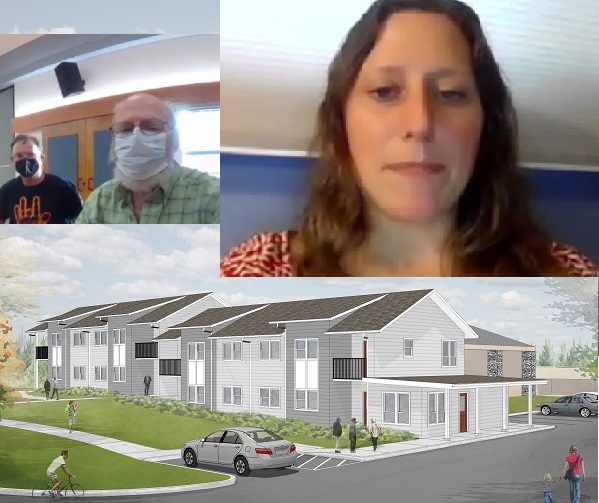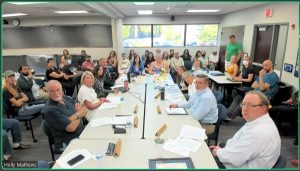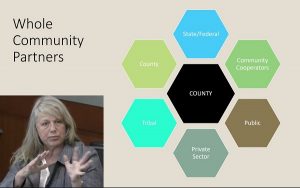SVdP shares plans for West Amazon site
7 min read
When bulldozers removed the playground, neighbors wondered what was happening. At the Aug. 9 meeting of the Southeast Neighbors board, co-chair Dennis Hebert.
[00:00:09] Dennis Hebert: We have Bethany Cartledge, who is the deputy director of St. Vincent de Paul. And she’s going to enlighten us a little bit about what is going on at West Amazon and Fox Hollow.
[00:00:23] Bethany Cartledge: We are doing two primary shifts at that property. One is the eight-plex construction, and it’s all been made possible with private funding from CBT Nuggets, with the intent to create transitional housing, scheduled to physically launch September 2023. The construction should only take eight months in total. It’s going to have eight two-bedroom, one-bath units with 800 square feet.
[00:00:50] The families are going to be provided with wraparound services and case management with the intent to create opportunities for families who are exiting poverty and homelessness to meet that critical gap between emergency housing and sustainable affordable housing solutions.
[00:01:08] So that’s the eight-plex construction that’s been taking place on the property. And then the other one is expanding what we’re currently offering at the annex to enable some of the night shelter families to stay on site.
[00:01:22] Bethany Cartledge: The Night Shelter Annex is a low-barrier 90-day wraparound case management shelter program for families experiencing homelessness in Lane County. Current services have included dorm units, laundry, showers, meals, and access to case management. And then it’s recently expanded to include day services, particularly for families who are currently sheltered within the annex.
[00:01:46] We’ve been looking at expanded childcare for low-income families. And that in conjunction with some staffing challenges led us decide to consolidate some of the day access services over to the one location, so that families who are currently served in the night shelter annex are not transported over during the day, but are able to remain on site and access the case management wraparound services, laundry,…
[00:02:09] We have 22 families who are currently in our night shelter program. For the first week we’ve had 38 adults, 29 children. For some of the day services we’ve had 29 additional individuals come by to receive day services, wraparound support. We’re looking to provide additional services to some of the families that we’re serving through DHS and White Bird, similar to what we do at some of the other locations.
[00:02:35] And then we have our First Place Kids program, which is currently at the annex from 9:30 to 11:30 a.m. with a long-term goal of expanding the childcare initiative at the 1995 Amazon Parkway location. The First Place Kids is a program of First Place Family Center or The Annex, and it’s a service provided to families experiencing homelessness.
[00:02:58] It provides access to early childhood education and care for children who are ages zero to five years old, with the goal to reduce barriers to early childhood education. We typically have partnered with the U of O and they’ve come by with different interns to help assess early childhood development.
[00:03:15] John Q: First question: Who’s using the small metal houses in the north parking lot?
[00:03:20] Bethany Cartledge: So we’re currently looking to retire the Pallet Shelters. The Pallet Shelters were provided to a variety of nonprofits around town, and we had used them, once upon a time, for families to have a pod where it’s quiet, it’s more contained, or if the family needed to isolate or quarantine, we’re able to provide ’em a safe space to do so.
[00:03:42] The pallet shelters are not something that we want to utilize long term. We don’t find them sustainable. We prefer to move people into permanent supportive housing. So they’re currently used on a case by case basis as needed for, families who maybe need to isolate for a variety of issues, but long term, we hope to retire those.
[00:04:03] John Q: What are your frequently asked questions?
[00:04:08] Bethany Cartledge: I have been able to assure the neighbors who are directly facing that construction, that it would not impact or impede traffic. That was a major concern that had come up was any rerouting or I impediment to traffic.
[00:04:20] Another concern has been hearing children outside. We do have our First Place Kids just 9:30 to 11:30 and it’s with supervision with the teachers in our First Place Kids program. But that’s another example of a concern I’ve heard, because there are some parents who said that they were working from home. And so they were worried about the noise level. So we’ve been trying to work really closely with those neighbors.
[00:04:42] And then another one that had been raised was just the visibility of families smoking outside. And so I’ve been working with our emergency services director and we’re relocating some of that. We want to be as collaborative as possible with the neighborhood to ensure that this is a beneficial project for both sides.
[00:05:02] Dennis Hebert: Do y’all have to do a traffic study or do you have any idea how many vehicles will be exiting and entering during the day at all?
[00:05:10] Bethany Cartledge: We have the 22 families and typically a quarter of them do not have vehicles. We still have a staff member who’s at the former facility. So we’re still utilizing our bus to transport individuals. So we’re hoping to minimize increased traffic as much as possible just by having the former facility be an area where people are able to leave vehicles and be transported over because a lot of the families who are coming to access services are coming to access a point in time (service). So: laundry, a meal, case management support. And so still enabling that other facility to have a staff member present has helped us to keep this a happy transition.
[00:05:47] John Q: One board member wondered about use of the LTD buses.
[00:05:52] Jess Roshak: We have a transportation committee that regularly tries to advocate for our neighborhood with LTD services. And I know that bus stop there, with a quarter of your families not having their personal transportation, are they using St. Vincent’s shuttle? It sounded like, or are they not using LTD and what’s the situation there?
[00:06:14] Bethany Cartledge: There’s been a blend. So we have through our social service office, we issue bus passes for individuals who regularly use public transportation.
[00:06:23] And then recognizing that First Place Family Center has been there since the ’90s and people have a built-in recognition of: ‘You go to 1995 Amazon Parkway for services.’ We expect to do a lot of transportation from that facility to the annex, because we don’t want to eliminate services to families who are seeking assistance because of transportation.
[00:06:45] And this is, on our end, a little bit of a pilot study. We really empower some of the program managers to take the lead to assess: Is this something that’s going to be sustainable in the long term, and we’re closely monitoring. Transportation is one of the keys.
[00:06:59] Another key is, with construction happening for the eight-plex, how disruptive is that for the families who are currently accessing services? But when we’ve been having some of the conversations with the families in the Night Shelter Annex, one of the largest complaints had been the movement.
[00:07:14] So they’re able to have a stable shelter for the 90 days, but they’re relocated every day. And so we’re trying to kind of balance making sure that if you’re in the Night Shelter program, you have some level of stability, but also if you’re not in the Night Shelter program, you’re not being overlooked or missed because of this move.
[00:07:35] So this is something where, our executive of director Terry (McDonald) has been doing monthly meetings with all the staff. He expects to do so through the end of the year to take a close look at what’s working, what’s not working, what do we need to shift?
[00:07:50] Emily Fox: I gather you’re creating eight more units. The new eight units are more permanent whereas the other 20 are for like almost emergency (yes) housing?
[00:08:00] Bethany Cartledge: One is like a low-barrier emergency 90-day shelter, where we’re assessing individuals who may be coming from a domestic violence situation. They may be displaced from a fire or personal family emergency. The 22 units are for families experiencing homelessness, and it’s pretty easy to get on that wait list.
[00:08:21] Whereas the other one is a two-year transitional housing program, has to go through Fair Housing standards. We would need to open this up for any community member who is seeking transitional housing.
[00:08:32] So we’re still working out the programmatic details, but anyone who would be living in that eight-plex would go through the same process of an individual seeking housing somewhere else. So there’d be a background check and they’d be paired with a case manager, so we would be working alongside those individuals. But it’s a different population than people directly in the night shelter program.
[00:08:53] Dennis Hebert: Thank you so much, Bethany. And maybe you could give us an update maybe sometime in the winter touch base with me because I belong to another organization called Altrusa International and we’ve been working with the annex on giving books to the kids and various other things. And I think y’all did a marvelous job on it, just really nice. We appreciate you being in the neighborhood.



